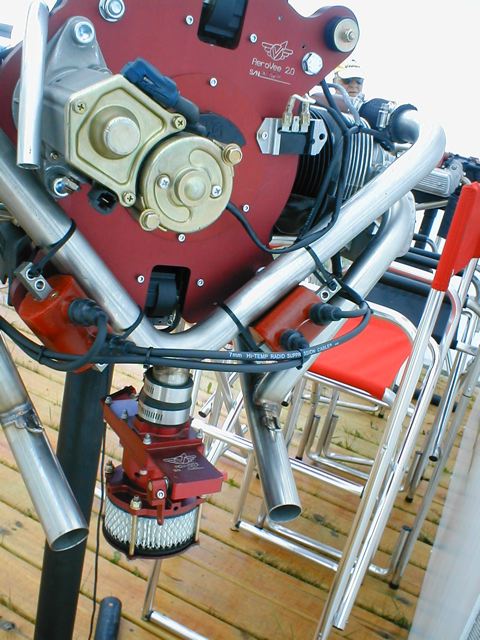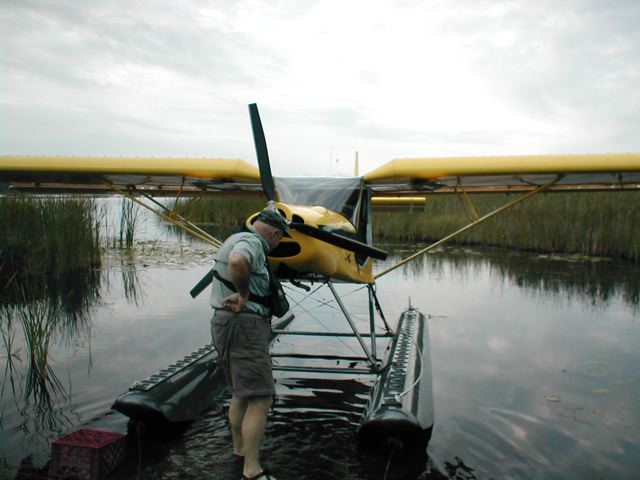| George, I just got back from Oshkosh which would have been a wasted trip except that I got to fly a CH 701 amphib off the water. This was a first for yours truly. What a lot of fun. The airplane handles perfectly and is the right one for me. It is limited by the designer to 100 hp and 200 lbs for the engine installation. So I am in the in enviable situation of not wanting to get too much out of my p port. The plane was powered by a 100 hp Rotax. It did very well.
Re your analysis comparing side ports with p ports, I wonder if such an analysis is even possible as they are quite different. Anyway, I doubt that a standard port can deliver 100 hp or a street port 130 hp. per rotor, certainly not when limited to 7500 rpm. Of course I am only guessing. No real knowledge or experience.
The only carb I saw at Oshkosh was the aero carb. It is sized by HP and they recommend the 38mm for 125 to 160 hp. This is too large for my purposes. I am considering going down to 35mm (90 to 125 hp) The problem is that I already have 38mm p ports. Also, of interest is that they do not recommend ram air. That simplifies the plumbing and the cowl. The demo engine had rather long, small dia runners and an air filter attached to the carb. That is the "system." ((on an 80 hp v.w.)) If I can get the drive figured out, I will build it with RB's aluminum side plates and Atkins eccentric. BTW the 701 is a high wing. The system will be strictly gravity. Jerry

 On Jul 21, 2007, at 10:14 PM, George Lendich wrote: Jerry, I'm trying to compare the carb inlet area to port or P-port areas. Standard Port area 32 deg ATDC to 50 degree ABDC = 1.18 sq " each side (x2 = 2.36sq")- using the front and back housings only. A street port will be 1.5sq" x 2 = 3sq" . A 44mm P-port = 2.35sq" A 42mm p-port = 2.14sq" A 40mm P-port = 1.94sq" A 38mm P-port = 1.75sq" So you see a side port on a single has more port area than a small P-port. Perhaps the velocity will make up for less area. The street port is bigger again at 3 sq" - this equates to 50mm port. The standard port gives about 100 hp, the street port about 130hp each rotor. I wouldn't want to choke down the port areas with too restrictive inlet carby area. I can't see how a 38mm will cut the mustard when your own calculations suggest 1.6 P-port = 42mm sq". In reality I'm only looking for 130HPat most, if I can get that. I can run a 41mm ID SS tube p-port with a 42mm Carby ( and hope velocity makes up the difference) Or I can run with two 1.5 street ported side ports 3 sq" with two smaller carbs, perhaps 2x32mm. BTW street ported 13B has been dynoed to 264hp can't remember the RPM - it might have been higher than what we run. More confused than ever! Does anyone know the IO/IC and size and HP of the factory P-port. Lynn, does the timing given, calculated by the rotor uncovering and covering the port, or the side seal uncovering/covering the port opening? I was thinking the RX8 rotor will be slightly different (bigger) with the harased edges. George ( down under) ----- Original Message ----- Sent: Sunday, July 22, 2007 9:17 AM Subject: [FlyRotary] Re: carbs vs efi
George, maybe I have the wrong idea, but I don't understand why you need such a large bore carb for the single rotor. No way you are going to produce more than 150 hp. I think 38mm would be enough. This is what Aero Carb recommends for the 0-320. Jerry
On Jul 21, 2007, at 5:56 PM, George Lendich wrote: Jerry, Looks like Pat was wrong about Revmaster having a 44mm, the biggest they go to is 42mm ( at the present time) and that costs $380. If I remember the 32mm costs $320. Jerry I would be interested in feed back on what you thought about the Aero Carb, especially how it's constructed - their all a little different. I do like the Ellison but it's too bloody expensive. George ( down under)
George, the web site says $326.00. You might want to compare the aero carb which is similar. http://www.aeroconversions.comI will be looking at both at Oshkosh on Tuesday and Wednesday next week. Jerry
On Jul 20, 2007, at 10:06 PM, George Lendich wrote: I have been surprised at the recent flurry of carb postings. I assumed that everyone was doing EFI. having experienced total electrical failure in march on a trip to the Bahamas I was thinking a lot about that Neanderthal carb bolted under my O320 and the magnetos, all unaware of what was going on in the radio, GPS, and nav lights departments. the reality is that you don't want a reserve battery to get you to the ground safely, you want to get to the Bahamas and back and THEN look into what's wrong. my questions are "how much power/performance is lost with a carb, and which carbs can do manual mixture?". is it stupid to ask if the Lycoming carb could run a 13B? someone mentioned Harley carbs having a good history of rough service. what about marvel/schebler? is this question heresy? :-) isn't efi a bit of overkill for an engine that basically runs at 100% power, 75% power and idle? scanning thru the archives I see a lot of postings regarding mixture, mapping, abrupt failures and such. does this complexity buy us 5%, 20%? the question of turbo-charging seems to beg similar line of questioning. kevin Kevin, It's probably my fault, with a number of chaps helping me out with information. My Buddy Bill Jepson will tell you nothing beats EFI and when it's running well, he's absolutely right! Not only that it is the best for fuel efficiency, leaning reading fuel flow etc. etc. However I'm developing a single rotor and looking at all sorts of issues including cost effectiveness of less elaborate installations. I'm also not keen on high pressure fuel under the cowl. Most importantly I'm not an electronics person and seeing the problems experienced by others has me more than a little nervous, in regard to EFI. Of course I know very little about carbies, so their helping me with this as well. The Revmaster might be the choice for me, but I'm awaiting the sticker shock! George ( down under)

P1010005.jpg

P1010016.jpg
|